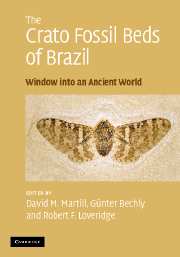Book contents
-
Frontmatter
-
Contents
-
Contributors
-
Preface
-
Acknowledgements
- Part I
The Crato Formation Konservat Lagerstätte
- Part II
The invertebrate fauna
- Part III
The vertebrate fauna
- Part IV
The flora
- 19
The macrophyte flora of the Crato Formation
- 20
Spores and pollen from the Crato Formation: biostratigraphic and palaeoenvironmental implications
- Part V
Miscellanea
-
Appendix: species list for the Crato Formation
-
Systematic index
-
Plate section
- References
19 - The macrophyte flora of the Crato Formation
Published online by Cambridge University Press: 22 August 2009
- Frontmatter
- Contents
- Contributors
- Preface
- Acknowledgements
- Part I The Crato Formation Konservat Lagerstätte
- Part II The invertebrate fauna
- Part III The vertebrate fauna
- Part IV The flora
- 19 The macrophyte flora of the Crato Formation
- 20 Spores and pollen from the Crato Formation: biostratigraphic and palaeoenvironmental implications
- Part V Miscellanea
- Appendix: species list for the Crato Formation
- Systematic index
- Plate section
- References
Summary
Introduction
Plant fossils from the Crato Formation are not only remarkable because of their beauty, but equally because of their scientific value, being on the cusp of the gymnosperm decline and the angiosperm radiation. Many of these fossils are preserved more or less entire, often with roots, stems, leaves, sporangia and flowering structures attached; there is also palaeosoil present in some specimens (Figure 19.1). The more or less complete fossils are not only attractive, but are of immense importance to the palaeobotanist, who often has to deal with dispersed organs, of which the natural connection remains unknown, until a more complete specimen is found.
The original organic material of the Crato plant fossils is generally covered or replaced by goethite, a hydrated iron oxide, which causes the rusty, conspicuous colouring of the weathered fossils. Often, they are very weathered, poorly preserved and can only be seen as reddish brown impressions on the light yellowish slabs. In rare cases, mainly in specimens coming from layers at the base of the section, black organic material with cellular structures can be preserved. Then, fine details, even of reproductive organs – the most indicative parts concerning the taxonomic evaluation of a plant – may be observed three-dimensionally with scanning electron microscopy (SEM).
The palaeoflora is known to be relatively diverse, but has not been fully described. It is now being investigated by an international team of researchers from various Brazilian and European institutions (FAPESP/Fundaçao de Amparo à Pesquisa do Estado de São Paulo).
- Type
- Chapter
- Information
-
The Crato Fossil Beds of BrazilWindow into an Ancient World, pp. 537 - 565Publisher: Cambridge University PressPrint publication year: 2007
References
- 28
- Cited by



